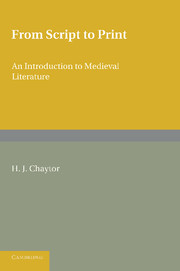Book contents
Summary
FEW historians would care to contest Bacon's statement that the inventions of printing, gunpowder and the mariner's compass have changed the form of civilisation, and all would probably agree that he placed these inventions in the order of their relative importance. While much has been written upon the importance of printing as accelerating the diffusion of culture and knowledge, few attempts have been made to contrast the mental attitude of the scholar and the literary man in the ages before print with that of the reading and writing public when print had superseded manuscript as a medium for communicating ideas. The difference is that between the medieval and the modern world. Book collectors have agreed to regard 1500 as the date after which incunabula begin to lose their scarcity value and their interest as illustrating the development of the printer's art. This choice of date is arbitrary and somewhat misleading; printing began later in some countries than in others, and in Spain, for instance, the dividing line might be placed some thirty or forty years later. But in 1492 Columbus made his great voyage, in 1494 Charles VIII invaded Italy, in 1500 Copernicus was lecturing in Rome, Erasmus and Luther were at work and in 1521 the Diet of Worms was held, while in the previous year Magelhaẽs had circumnavigated the globe. In the effects of such events the difference between medieval and modern is apparent, in the enlargement of outlook upon the world and the interpretation of man's place and powers in it. That extension of view would have unfolded much more slowly than it did, if the printer had not already been at work for half a century.
What picture, then, can be drawn of a man of letters, of his culture and capacity in medieval times? As a text, we may take the eulogy composed by Guittone d'Arezzo, who was born about the middle of the thirteenth century:
Tu frate mio, vero bon trovatore
in piana e'n sottile rima e chiara
e in soavi e saggi e chari motti,
Francesca lingua e Proensal labore
più de l'Ar(e)tina è bene in te, che chiara
la parlasti e trovasti in modi totti.
- Type
- Chapter
- Information
- From Script to PrintAn Introduction to Medieval Literature, pp. 138 - 141Publisher: Cambridge University PressPrint publication year: 2013



